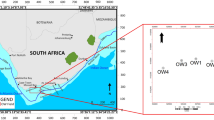Abstract
The southern section of the Zagros zone in southwestern Iran, a well-known sedimentary basin, was investigated to address two key questions: (1) whether it would be feasible to construct large unlined rock caverns (URCs) in moderate-quality sedimentary rocks of this area for the storage of crude oil, and (2) which parts of this wide area were most suitable for constructing such huge underground structures. To answer these questions, first, the geological, hydrogeological and engineering geological properties of typical rock units in the area were investigated, and preliminary analyses were performed to check the stability, permeability and water circulation conditions of typical rock masses at depth. Next, geographical information system (GIS) techniques were applied to select the best regions for constructing the URCs. Parameters including geological characteristics, governmental restrictions, and proximity to facilities were selected as important factors for area zonation and for preparing a suitability map for constructing URCs for storing crude oil. The results of the study indicated that limestone units of the Asmari and Sarvak Formations at a moderate depth (200–300 m) were the most appropriate rock units for construction of URCs with a cross-section area of around 500 m2. In addition, the suitability map showed that two small regions in the central and northern parts of the study area were best suited for URC construction. The key advantages of these regions include a wide distribution of surface exposures of good-quality stratigraphic units (Asmari and Sarvak Formations), limited distribution of active tectonic structures such as salt domes and faults, and proximity to crude oil facilities.












Similar content being viewed by others
References
Alavi M (2007) Structures of the Zagros fold-thrust belt in Iran. Am J Sci 307:1064–1095. doi:10.2475/09.2007.02
Benardos AG, Kaliampakos DC (2005) Hydrocarbon storage in unlined rock caverns in Greek limestone. Tunn Undergr Space Technol 20(2):175–182
Bosák P, Jaroš J, Spudil J, Sulovský P, Václavek V (1998) Salt plugs in the Eastern Zagros, Iran: results of regional geological reconnaissance. GeoLines 7(1998):174
Broch E (2016) Planning and utilization of rock caverns and tunnels in Norway. Tunn Undergr Space Technol 55:329–338
Hassanpour J, Mohammadnejad M (2014) Investigating feasibility of constructing unlined rock caverns for storing crude oil in Asmari formation. First underground oil and gas storage conference, University of Tehran, 19–20 May 2014
Hassanpour J, Ghiasvand S, Tarigh Azali S (2013) Zonation of Persian Gulf and Oman Sea coastal regions for constructing unlined crude oil storage caverns. 10th Iranian tunneling conference, Iranian tunneling association (IRTA), Tehran, Iran
Haug SM (2007) Storage of oil and gas in rock caverns below the ground water table—general design development. Norwegian Tunneling Society, Norway, pp 19–25
Jahani S (2008) Salt tectonics, folding and faulting in the eastern fars and southern offshore provinces (Iran). PhD Thesis, Université de Cergy, Pontoise
Koleini M (2012). Engineering geological assessment and rock mass characterization of the Asmari Formation as Large Dam Foundation rocks in southwestern Iran (Zagros range). PhD Thesis, University of Pretoria, South Africa
Lee C, Song J (2003) Rock engineering in underground energy storage in Korea. Tunn Undergr Space Technol 18(5):467–483
Price DG (2009) Engineering Geology, principles and practice. Springer, Berlin
Price DG, Rengers N, Hack HRGK, Brouwer T, Kouokam E (1996) Problem recognition index applied to the falset area. Congrés del Priorat, Spain
Sturk R, Stille H (1995) Design and excavation of rock caverns for fuel storage—a case study from Zimbabwe. Tunn Undergr Space Technol 10(2):193–201
Tavakkoli B, Ghafouri Ashtiani M (1999) Earthquake hazard map of Iran, International Institute of Earthquake Engineering and Seismology (IIEES). Taylor & Francis, Iran
Tezukaa M, Seokab T (2003) Latest technology of underground rock cavern excavation in Japan. Tunn Undergr Space Technol 18(3):127–144
Vergés J, Saura E, Casciello E, Fernàndez M, Villaseñor A, Jiménez-Munt I, García-Castellanos D (2011) Crustal-scale cross-sections across the NW Zagros belt: implications for the Arabian margin reconstruction. Geol Mag 16:1–23
Author information
Authors and Affiliations
Corresponding author
Rights and permissions
About this article
Cite this article
Hassanpour, J., Firouzei, Y. & Hajipour, G. A regional-scale engineering geological study for selecting suitable rock masses for constructing unlined oil storage caverns in Southern Zagros, Iran. Bull Eng Geol Environ 78, 267–280 (2019). https://doi.org/10.1007/s10064-017-1035-2
Received:
Accepted:
Published:
Issue Date:
DOI: https://doi.org/10.1007/s10064-017-1035-2




